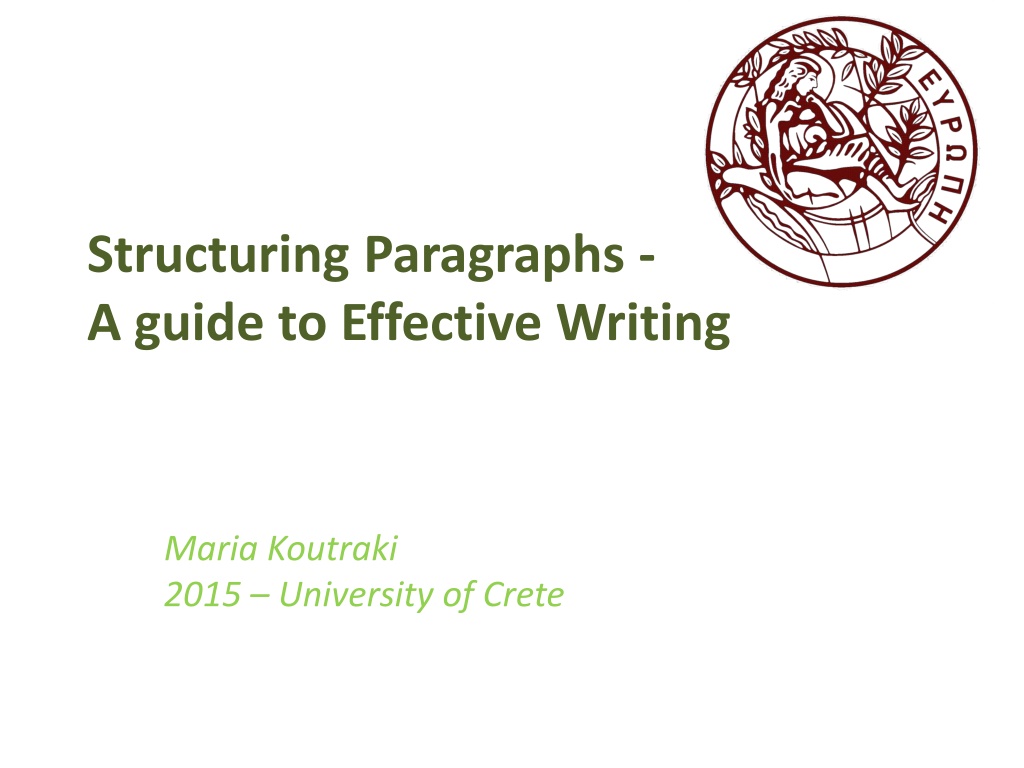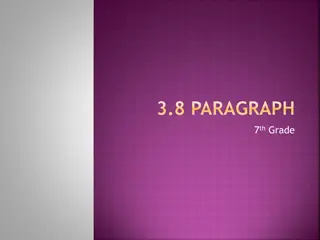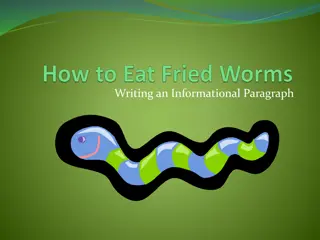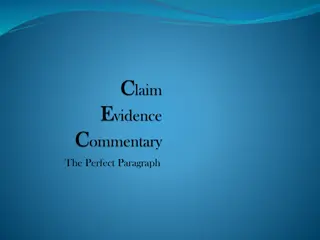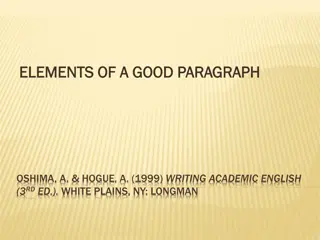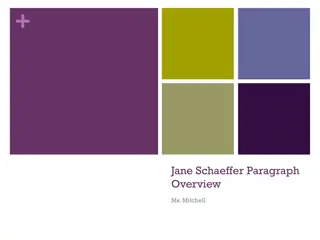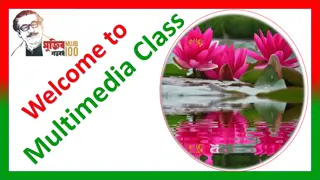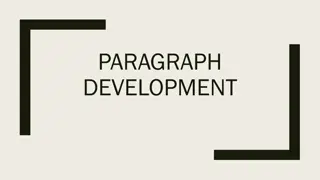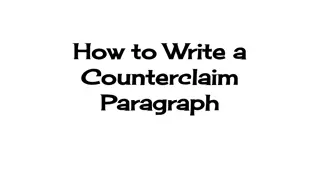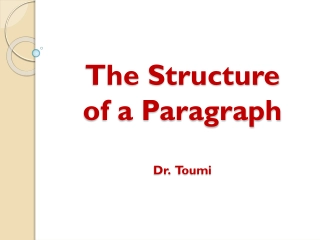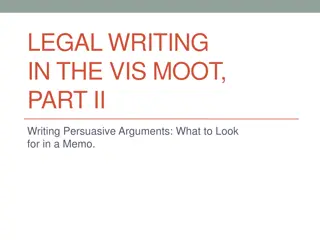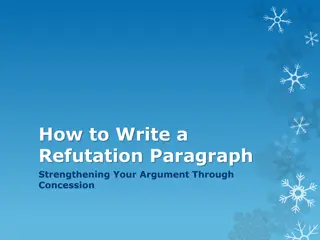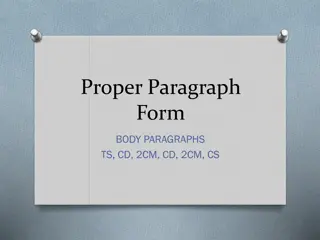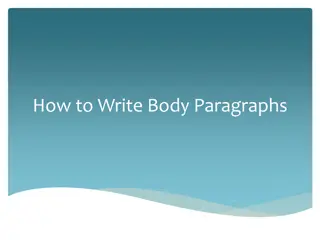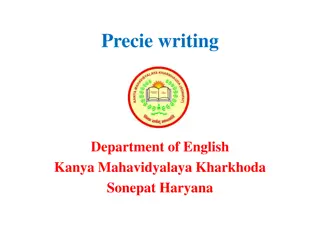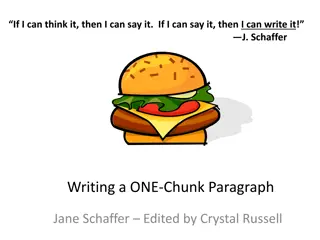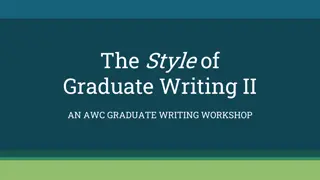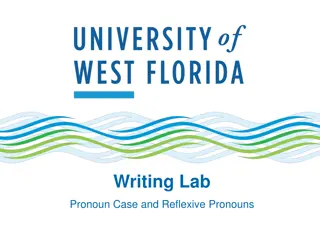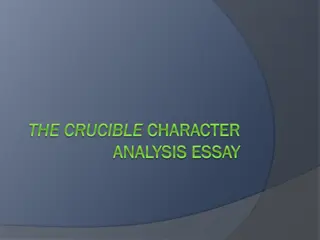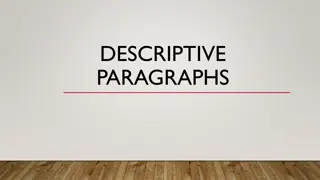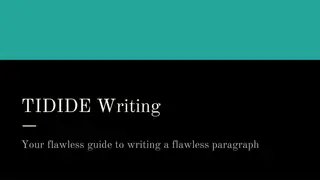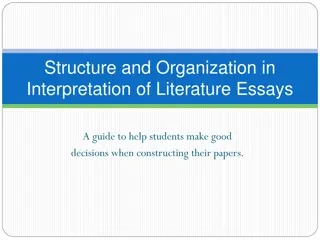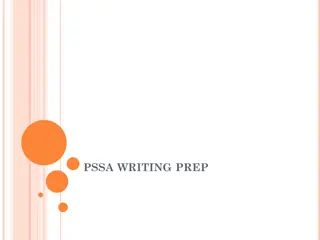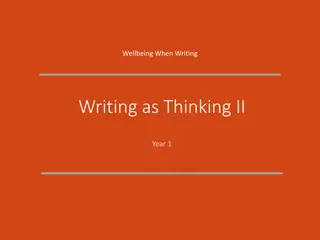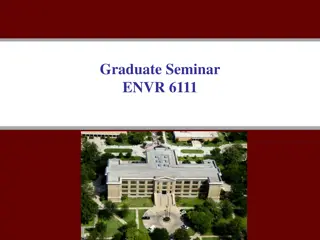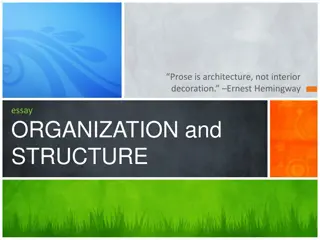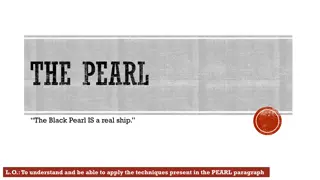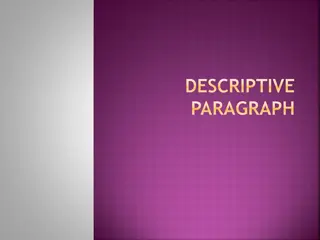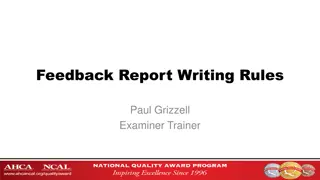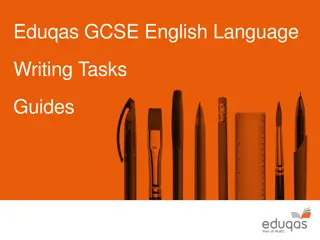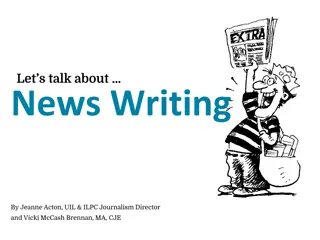Mastering Paragraph Structure for Effective Writing
Explore the art of structuring paragraphs for clear and convincing writing. Learn about the general-to-specific approach, the importance of topic sentences, paragraph unity, and the role of primary and secondary supports in reinforcing your ideas. Enhance your writing skills by understanding how to maintain coherence and focus throughout your paragraphs.
Download Presentation

Please find below an Image/Link to download the presentation.
The content on the website is provided AS IS for your information and personal use only. It may not be sold, licensed, or shared on other websites without obtaining consent from the author. Download presentation by click this link. If you encounter any issues during the download, it is possible that the publisher has removed the file from their server.
E N D
Presentation Transcript
Structuring Paragraphs - A guide to Effective Writing Maria Koutraki 2015 University of Crete
The General -to -Specific Paragraph To understand the basics of clear writing it is useful to examine first the general-to-specific expository paragraph. A general-to-specific expository paragraph is a group of sentences that present a unified topic or idea. It moves from a general opening statement to specific supporting statements. It is usually built with three levels of generality: the general opening statement, less general supporting statements, and further details that elaborate on the supporting statements. No other sentence of the same level of generality as the opening statement should appear in the paragraph.
How to Begin Writing Paragraphs The writer s first concern is to find an appropriate topic on which to write a paragraph. The writer should be familiar enough with the topic to develop it effectively in the paragraph. The topic sentence is usually the first sentence in a general-to- specific paragraph and expresses the topic and the controlling idea of the paragraph. The rest of the paragraph explains or justifies the topic sentence. The controlling idea limits the topic by focusing on one aspect of it and thus determines the direction that the rest of the paragraph will take. The aspect to be focused on is signaled by certain significant words or phrases in the topic sentence. The writer should clearly develop the aspect of the topic and also avoid including in the paragraph any material which is not related to the controlling idea.
Paragraph Unity and Structure Every expository paragraph should be unified. Every sentence should support the controlling idea. The more unified the paragraph, the clearer and more convincing it will be. The best way to achieve unity is through careful planning. First select a topic and a controlling idea and write a topic sentence in which they are expressed. Under your topic sentence, jot down facts and ideas which come to mind as possible support for your controlling idea. Scan your list and make sure that your controlling idea is valid and supportable. Select those items which will best serve as primary support for the controlling idea and write sentences of primary support about them. Primary support sentences directly support the controlling idea and can be further developed by other details that you have listed. Often primary supports require additional details or explanation to be convincing to the reader.
Paragraph Unity and Structure The sentences in a paragraph that reinforce a primary support by supplying additional details or explanation are called secondary supports. Secondary supports relate directly to a sentence of primary support and indirectly to the paragraph s controlling idea. Most problems in unity occur on the level of secondary support, where it is easy to lose sight of the controlling idea. When you choose the secondary supports for your paragraph be sure that they effectively reinforce your sentences of primary support. Do not use secondary supports that simply digress into related areas. Even occasional digressions on the level of secondary support can seriously harm the effectiveness of your writing. As a writer you must learn to decide how many primary and secondary supports are needed to reinforce the controlling idea of your paragraphs. A good rule of thumb is to use three primary supports and two secondary supports for each primary support.
Sample Paragraph For example, suppose that you want to write a paragraph about the natural landmarks of your hometown. part of your paragraph The first like might look this: My hometown is famous for several amazing natural features. First, it is noted for the Wheaton River, which is very wide and beautiful. Also, on the other side of the town is Wheaton Hill, which is unusual because it is very steep.
Sample Paragraph Here we can see our paragraph about Wheaton with a few more supporting sentences in bold font: My hometown is famous for several amazing natural features. First, it is noted for the Wheaton River, which is very wide and beautiful. Also, on the other side of the town is Wheaton Hill, which is unusual because it is very steep. The third amazing feature is the Big Old Tree. This tree stands two hundred feet tall and is probably about six hundred years old.
Sample Paragraph Let's see how a concluding sentence (in bold font) might look in our sample paragraph about Wheaton: My hometown is famous for several amazing natural features. First, it is noted for the Wheaton River, which is very wide and beautiful. Also, on the other side of the town is Wheaton Hill, which is unusual because it is very steep. The third amazing feature is the Big Old Tree. This tree stands two hundred feet tall and is probably about six hundred years old. These three landmarks are truly amazing and make my hometown a famous place.
EXAMPLE OF AN ACADEMIC PARAGRAPH A number of problems associated with the traditional routines of handover practices have been identified. Baldwin and McGinnis (1994, pp. 61-64) find that many handovers are unnecessarily lengthy which means that there is an unacceptable period of time during each shift when nurses are not available in the ward or unit. Another area that has received attention is the content and presentation of handover information. Wills (1994, p. 36) observes that an unprofessional approach has been noted among some nurses, with derogatory comments about patients or their families . Lastly, there is the issue of what information nurses actually pass on during the handover. It appears that: Nurses frequently report on their own activities over the shift rather than providing patient centred information. Information obtained from discussions with relatives is rarely relayed onto other nursing staff, and of the patient information reported, most is described from a medical perspective rather than focusing on the discussion of nursing related information. (Professional Nurse, 1997, p. 637) Thus, many serious problems have been identified in traditional handover practices which may reflect on the professional standing of nurses in this profession. Note the use of in-text references, paraphrases, short & long direct quotes to support the writer s argument.
Methods of development 1. Example In a paragraph developed by the use of examples, all the examples should be appropriate that is, they should support the controlling idea of the paragraph. All examples should be specific. The writer should use enough examples to make the paragraph convincing. Three or more examples are usually needed, but one extended example may sometimes be effective.
Sample Paragraph In Harry's world fate works not only through powers and objects such as prophecies, the Sorting Hat, wands, and the Goblet of Fire, but also through people. Repeatedly, other characters decide Harry's future for him, depriving him of freedom and choice. For example, before his eleventh birthday, the Dursleys control Harry's life, keeping from him knowledge of his past and understanding of his identity (Sorcerer's 49). In Harry Potter and the Chamber of Secrets, Dobby repeatedly assumes control over events by intercepting Ron's and Hermione's letters during the summer; by sealing the barrier to Platform 93 4, causing Harry to miss the Hogwarts Express; and by sending a Bludger after Harry in a Quidditch match, breaking his wrist. Yet again, in Harry Potter and the Prisoner of Azkaban, many adults intercede while attempting to protect Harry from perceived danger, as Snape observes: "Everyone from the Minister of Magic downward has been trying to keep famous Harry Potter safe from Sirius Black" (284). All these characters, as enactors of fate, unknowingly drive Harry toward his destiny by attempting to control or to direct his life, while themselves controlled and directed by fate. Julia Pond, "A Story of the Exceptional: Fate and Free Will in the Harry Potter Series"
Methods of development 2. Cause & Effect Use cause and effect when you want to show why an event has occurred (by examining its causes) or when you want to show what happens as a result of the event (by examining its effects). Be sure that you cite important causes and effects and that you present them convincingly. Be sure that you deal with causes or effects that are clearly and directly related to the event under consideration. Do not mistake mere conditions for active causes or effects.
Sample Paragraph The Misuse of Credit Cards While credit cards are convenient and easy to use, the misuse of credit cards can lead to serious problems. Today, many consumers are spending beyond their ability to pay. This often leads to serious financial difficulties or even personal bankruptcy. One of the reasons for consumer over-spending is aggressive promotion by credit card companies. Fancy commercials and advertisements are everywhere and they create the image that using credit cards is easy and trendy and gives people class. They offer tempting low introductory rates and other benefits. Instead of worrying about payment with high interest rates, card users tend to get carried away and find immediate satisfaction in fulfilling their desires. Incredibly, many people seem unaware that credit cards are not free; people may not feel like they are spending money, but they are creating debts that have to be paid. They often lose track of how much they are spending. And they don't realize how quickly many little purchases can add up until they receive their next credit card bill. To avoid problems with credit card debt, people need to become educated in personal financial management. information isn't as easily available to consumers as credit card advertisements that promote the freedom and benefits of credit card use. Source: http://rbigausk.disted.camosun.bc.ca/6methodsofdev6.htm#Cause and Effect Unfortunately, this kind of
Methods of development 3. Process Analysis A process involves a number of events which are customarily repeated and which lead to a specific end. In developing a paragraph through process analysis, the writer should include all the important steps that are either necessarily or customarily involved in the process. The steps in the process should be presented in the order in which they necessarily or customarily occur.
Sample Paragraph In brief, the mummification process may be summarized as follows: extract, sterilize, dehydrate, perfume, seal, tag, and stock. All were done ceremoniously and with due respect to the dead body. The viscera were extracted through an incision about 10 inches long, usually made in the left side of the abdomen. Through this incision, all the "floating" contents of the abdominal cavity, namely, the stomach, the liver, the spleen, and the intestines, were removed but the kidneys were left in place. The diaphragm was then cut and the thoracic contents removed through the abdominal incision. The heart, which was considered the center of emotions and the seat of conscience, was left in place. The ancient Egyptians seem to have attached no importance to the brain, which was removed through the ethmoid bone. Following these extractions began the slow process of sterilization and dehydration of the body, accomplished by osmosis with dry natron. Resterilization of the cavities, perfuming, closing the incision, and wrapping the body with linen and with beeswax completed the process. Molten resin was used to seal the body and its wrappings, providing a barrier against insects and anaerobes. Adapted from Mohamed E. Salem and Garabed Eknoyan, "The Kidney in Ancient Egyptian Medicine: Where Does it Stand?"
Methods of development 4. Definition A formal definition of a term identifies the class to which the term belongs and the specific characteristics that differentiate it from other members of the class. A formal definition may form the basis of a paragraph. A formal definition may also be used to clarify the controlling idea of a paragraph that is not primarily concerned with the definition itself. When used in this way the definition of an important term in the topic sentence is interposed between the topic sentence and the rest of the paragraph. Informal definition is less structured and precise than formal definition. It aims to bring out the special connotations of the term being defined. Informal definition is often used to define abstract terms which do not lend themselves to satisfactory definition through formal definition, or to define everyday terms which are already well known. The choice of formal or informal definition is determined by context and by the attitude of the writer toward his subject.
Sample Paragraph Questions can be many different things. A question can be an inquiring sentence which asks for a reply, as in "I have a question for you." The word can also refer to whatever subject matter is at hand, as in the sentence, "The question of ethics is a hot topic nowadays." A question can refer to some sort of doubt or uncertainty, as in "There is no question I'm the best man for the job." Used as a verb, to question can mean the instance or act of questioning, such as "Police questioned the suspect." You can question whether something is right or question a celebrity for an interview. If you "pop the question," you are proposing to your sweetheart! Therefore, a question can mean many things to many people.
Methods of development 5. Comparison & Contrast Use comparison to consider the likenesses between two items. Use contrast to consider the differences between two items. In formal comparison or contrast, consider items that are in the same class, and make sure that the class is sufficiently narrow for the comparison or contrast to be meaningful. In formal comparison or contrast, select definite bases on which to rest a comparison or contrast, and restrict yourself to these bases in writing your paragraph. In a paragraph developed by formal comparison or contrast, you may use either the items under consideration or the bases as main headings in outlining your paragraph. Usually the latter is preferable. In informal comparison or contrast, you may relax the rules for formal comparison or contrast in order to support the controlling idea in a more effective way than formal comparison or contrast would allow. In informal comparison or contrast, you may place one or both items under consideration in a very broad or even an imaginary or farfetched class.
Sample Paragraph Synthetic Engine Oils: Worth the Price? Drivers who want the best protection for their engines will find that synthetic oil offers several advantages over conventional oil. First of all, it's better year round. Synthetic oil flows freely at all temperatures and circulates immediately at start up. temperatures and takes time to warm up. Synthetic oil is also more stable at high temperatures, making it more dependable in hot weather. Second, synthetic oil is much cleaner than conventional oil. It contains the finest detergents, rust inhibitors, and other additives that reduce friction and make the engine run smoother and cleaner. important, is that synthetic oil lasts longer. changed every three months or 5000 kilometres, whereas synthetic oil can last up to six times longer. Only the filter has to be changed over this period of time. Even though synthetic oil is much more expensive, it's worth the extra cost if you value the life and performance of your engine. Conventional oil thickens at low Third, and perhaps most Conventional oil must be
Methods of development 6. Classification Developing a paragraph by classification involves examining something by analyzing its basic parts. In formal classification, you must establish precise bases on which to rest the classification. In formal classification, you must be sure that no item falls into more than one class. In other words, make certain that classes are mutually exclusive. In informal classification, your point of view may be personal. Classes still must have precise bases, but the rule against overlap may be relaxed or, occasionally, ignored.
Sample Paragraph Policies of privatisation should be considered as responses to several distinct pressures. First, privatisation is a response by the state to internal forces such as increasing fiscal problems (O'Connor, 1973). It provides a means of lessening the state's fiscal responsibilities by encouraging the development of private alternatives which, theoretically at least, do not draw upon the state's financial reserves. Second, the promotion of private sector activity is a response to pressures originating 'outside' the state apparatus. These include demands from people who see a large state bureaucracy as inefficient and wasteful, demands from business interests who claim that they can overcome these inefficiencies, and pressures from client groups who seek to reduce their dependency on the welfare state by having more control over the services on which they depend. Clearly, this variety of calls for privatisation means that it is not a process with a uniform outcome; there exists a correspondingly wide variety of forms of privatisation. Adapted from Glenda Laws, "Privatisation and the Local Welfare State"
From Paragraph to Essay There are two basic ways to go about writing 1-3-1 expository essays. The first is to expand a general-to-specific paragraph into an essay. The second is the more direct procedure of simply writing an essay from scratch. To turn a paragraph into an essay, follow these five basic steps: Make the topic sentence of the paragraph the basis for the thesis sentence of the essay. Make the primary supports in the paragraph the topic sentences for the body paragraphs of the essay. Write the body paragraphs of the essay. Write an introductory paragraph for the essay. Write a concluding paragraph for the essay. When turning a paragraph into an essay, you will find that the secondary supports in the original paragraph can often be used as primary supports in the body paragraphs of the essay.
From Paragraph to Essay The introductory paragraph of an essay should accomplish three objectives. It should (1) capture the reader s interest, (2) state the thesis of the essay, and (3) introduce the divisions in the body paragraphs of the essay. There are several devices that you can use in an introductory paragraph to capture the interest of your reader. You may use (1) a personal testimony, (2) an anecdote, (3) a simple but well-focused generalization, (4) factual data, (5) a quotation, (6) a combination of these devices.
From Paragraph to Essay The concluding paragraph of a 1-3-1 essay should accomplish two main objectives: It should (1) restate the thesis and the divisions of the essay using words different from those in the introductory paragraph and (2) bring the essay to an end smoothly, without digressing into any new issues. There are several devices you can use to write effective concluding paragraphs for your essays. You can (1) refer to a fact, idea, or quotation introduction, as a means of tying the beginning and conclusion of the essay together, (2) make a prediction after you have repeated the thesis and divisions, and (3) make a recommendation after you have repeated the thesis and divisions. that you presented in the
From Paragraph to Essay If you understand the structure of a 1-3-1 essay and can effectively expand a paragraph into a 1-3-1 essay, you should have little trouble writing this type of essay from scratch. To write a 1-3-1 essay from scratch, follow these five basic steps: Select a topic. Write a thesis sentence. Select a method of development and organize the essay. Write topic sentences for the body paragraphs of the essay. Write the body paragraphs of the essay, and furnish a paragraph of introduction and a paragraph of conclusion.
From Paragraph to Essay In selecting a topic for an essay, use the same criteria which you used when selecting a topic for a paragraph. In order to write effectively about a topic, you need to be familiar with it, either from personal experience or from reading, watching television and so on. If you are assigned a topic, be sure to narrow it down sufficiently to make it manageable within the space of an essay. When writing a thesis sentence for an essay, be sure the thesis statement (or sentence) expresses a controlling idea that is neither too broad nor too specific to be developed effectively.
From Paragraph to Essay To organize an essay, select a method of development and write a basic outline for the essay. Often you will decide upon the method of development you want to use when you select your topic and write your thesis sentence. To make sure that you have chosen the best method available for developing your thesis sentence, check through the other methods before you finally settle on one. In writing an outline, begin by listing the major divisions which the body paragraphs in your essay will discuss; then fill in the primary supports that each of the body paragraphs of the essay will contain. The entries in your essay need not to be elaborate. Generally, a word or phrase for each topic sentence and each primary support sentence will be sufficient.
From Paragraph to Essay For each body paragraph, furnish a topic sentence that directly relates to the thesis sentence and that is developed by the primary supports of the paragraph. When writing introductory and concluding paragraphs, follow the same procedure that you used for writing introductions and conclusions to essays based on individual paragraphs. Keep in mind that an introductory paragraph should (1) state the thesis of the essay, (2) introduce the divisions in the body paragraphs of the essay, and (3) gain the interest of the reader. A concluding paragraph should (1) restate the thesis and divisions of the essay and (2) bring the essay to an appropriate and effective close without digressing into new issues.
Sample Essay The Three Africas When many people hear the word Africa, they picture steaming jungles and gorillas. Hollywood films have shrunk the public image of this immense, varied continent into a small segment of its actual diversity. To have a more accurate picture of the whole continent, however, one should remember that there are, roughly, three Africas, each with its distinct climate and terrain and with a style of life suited to the environment. The continent can be divided into the northern desert areas, the southeastern grasslands, and the tropical jungles to the southwest. The northern regions have the environment and living patterns of the desert. Egypt, Libya, Algeria, and Morocco have hot, dry climates with very little land suited to farming. Therefore, the population tends to be clustered into cities along rivers or the seacoast or into smaller settlements near oases. For thousands of years, people have lived in this vast region, subsisting partly on what crops and animals they could raise and partly on trade with Europe. The southeastern grasslands provide a better environment for animal life and for some kinds of crops. Many wild animals inhabit the plains in this region--elephants, giraffes, rhinoceros, antelopes, zebras, and lions. The people in this area have long been expert cattle raisers and hunters. Tea, coffee, cotton, cashew nuts, and tobacco are some of the main products grown in this region. Fishing also provides some food and income for people along the coast. The population here is less concentrated in cities and towns than in the north, but tends to be denser in areas where adequate rainfall and fertile soil make farming possible.
Sample Essay West Africa is the region closest to the Hollywood image of mysterious jungles. As in the other two regions, the way people subsist depends upon their environment. This does not mean that most of the people live in grass huts in the jungle. Such nations as Nigeria have become highly modernized by income from oil, timber, and minerals. Most of the western countries have some farming that provides food and income; sugar cane, coffee, and tobacco are the important cash crops, while bananas, rice, and corn are raised for food. Fishing in the rivers and along the coast also accounts for food and income, and precious stones, especially diamonds, enhance the economy of Angola and the Ivory Coast. Even a superficial look at the major regions of Africa shows that it is a varied continent with several environments. Although most of the continent is tropical in its range of temperature, the climate ranges from deserts to rain forests. Similarly, human life-styles vary from the simplest rural villages to industrial cities, both new and ancient. Contrary to the myth, however, jungle life makes up only a very small portion of the whole of Africa. (Source: http://www.taftcollege.edu/instruct/LiberalArts/OWL/sampfive.htm)
Sources Structuring Paperback June, 1996 http://rbigausk.disted.camosun.bc.ca/6methodsofdev6.htm# Cause and Effect http://lrs.ed.uiuc.edu/students/fwalters/para.html#topic http://www.writing.utoronto.ca/advice/planning-and- organizing/paragraphs http://slsuwritersblock.blogspot.gr/2010/10/method-of- paragraph-development-by_7567.html http://www.taftcollege.edu/instruct/LiberalArts/OWL/sampfiv e.htm Paragraphs: A Guide to Effective Writing
Suggested sources for practice www4.smsd.org/dianelampton/docs/Doc- 112176.pdf
